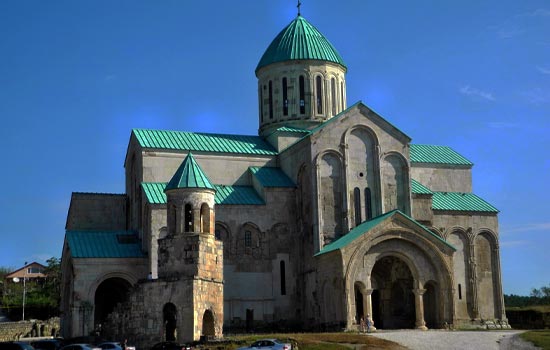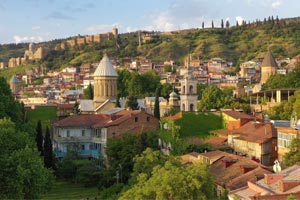|
Bagrati Cathedral Bagrati Cathedral is a special architectural monument of Georgia, which since its construction in 1003 has been in the centre of attention and has shared the turbulent history of the country. Even today, Bagrati is not just a part of history, but a current issue. The cathedral is like a living organism that has changed its appearance and meaning over the centuries, trying to adapt to the times. The name The cathedral is dedicated to the Dormition (Assumption) of Mary, but is called Bagrati, after its builder King Bagrat III. Bagrati Cathedral on YouTube Here you can watsch the aerial video of bagrati cathedral on our YouTube channel Short introduction The Bagrati Cathedral stands on Ukimerioni Mountain, in the central part of Kutaisi (Imereti Region). In the past, there was not only a cathedral but also the palace of the Georgian kings, surrounded by a defensive wall. For centuries, the Bagrati Cathedral and the royal palace, with its defensive wall, towers and other buildings, formed a fortification of great political, military and religious significance. The importance of the complex explains why Bagrati was the first and most frequent target of invaders. It also explains why the cathedral suffered so much during the Georgian-Ottoman wars and was finally almost completely destroyed by the Ottomans. It is important to note that the city of Kutaisi, where Bagrati Cathedral is located, was the capital of Georgia for centuries and continued to exist as the capital of Western Georgia and the Imeretian region even after the country was divided into various kingdoms. History Bagrati Cathedral As early as the 6th century, a large basilica, 30 metres long and 25 metres wide, stood on the site of Bagrati. This basilica was damaged during the Georgian-Persian wars and rebuilt in the 7th and 8th centuries. At the end of the 10th century, King Bagrat III managed to unite Georgia (with the exception of Tbilisi). As a symbol of the country's unity, he had a cross-domed church built, dedicated to the Dormition of the Holy Mother of God. According to the inscription on the northern façade, the cathedral was completed in 1003. In 1020, two richly decorated entrance portals were added to the south and west sides of the church. These portals are still clearly visible in the present cathedral, and fragments of the former frescoes are also preserved in the southern portal. After its construction, the new grandiose cathedral became the coronation and burial place of the Georgian kings. The first king to be crowned in Bagrati was Giorgi I (the founder of the Svetitskhoveli Cathedral in Mtskheta, but after his death in 1027 the Svetitskhoveli was not completed and it is assumed that he was buried in the Bagrati Cathedral). In the same year, 1027, the son of Giorgi I, Bagrat IV, was crowned in the cathedral. Later, in 1072, Giorgi II, the father of David the Builder, was also crowned here and it is believed that the coronation of King David also took place in Bagrati Cathedral. In 1230, Queen Tamara's daughter had her son David crowned in Bagrati Cathedral. In 1360, another very important Georgian king, Bagrat V, was crowned in the cathedral. In the following centuries, even after Georgia was divided into several kingdoms, several West Georgian kings were crowned in the cathedral. Fall of the Bagrati Cathedral In 1453, Constantinople fell, and with it the Georgians' most important Christian ally. A few decades later, in 1510, the Ottomans invaded western Georgia via the Akhaltsikhe region and the Zekari Pass and set fire to the royal palace and the cathedral. Interestingly, in 2003 an archaeological expedition found traces of the 1510 fire inside the cathedral. In the following 17th and 18th centuries, West Georgia, and in particular the capital Kutaisi with its Bagrati Cathedral, was often the target of Ottoman attacks. The situation worsened after the signing of the Treaty of Amasya in 1555 between the Persian and Ottoman Empires, which gave eastern Georgia to the Persians and western Georgia to the Ottomans. The cathedral suffered the worst damage in 1691. At that time, the cathedral and the royal palace were in Ottoman hands, and during a Georgian attempt to retake them, the Turks planted explosives in several corners of the cathedral and blew up this grandiose sacred building. But this was not the last battle for the cathedral. In 1770, when the Ottoman Empire was on the verge of defeat in its struggle against the Russian Empire, the East Georgian King Irakli II attempted to liberate the south of the country from the Ottomans. He won several important victories, most notably at the Battle of Atskuri. At the same time, the Western Georgian king, Solomon I, with the help of the Russian general Eduard Totleben, was also trying to liberate West Georgia from the Turks. (Totleben also 'helped' the East Georgian King Irakli II). The Russian general Totleben and the Georgian king Solomon captured several fortresses in western Georgia, eventually laying siege to the fortress at Kutaisi, the main garrison of Turkish troops. After a month of siege and artillery bombardment, it was finally taken. However, one can imagine what the cathedral and the whole complex must have looked like after a month of artillery bombardment. It was also interesting that after the victory in 1770, the Georgian king did not rebuild the destroyed castles and fortresses, but demolished all the captured installations, including the ruins of the fortress of Kutaisi. The idea was that if the Turks invaded again, they would not be able to gain a foothold in the region so quickly. Anyway, after the battle of Bagrati in 1770, all that was left of the cathedral was a huge ruin, and the former royal palace and defences of Kutaisi were history. King Solomon did, however, build a chapel in the southern portal of the cathedral (in a part that has survived to some extent). The bell tower was also restored at this time, and the frescoes in the south portal must date from the same period. This small church (partially rebuilt entrance) was the seat of the West Georgian Archbishop until 1820, and later served as a small spiritual school until the Bolsheviks came to power. In the 19th century, the cathedral narrowly escaped complete demolition. In 1837, the Russian Tsar Nicholas I travelled through Georgia, and all along his route, badly damaged churches were demolished, and even churches in good condition were painted white from the inside so that the Tsar would not have to see the damaged frescoes of the churches. The churches were 'restored', so to speak. The complete demolition of Bagrati was then estimated at 700 rubles and about 2 weeks, and either because time was short or to save money, Bagrati was left alone. From the second half of the 19th century a new era began for Bagrati. It was not restored, but its grandiose ruins were now admired by numerous visitors from Europe and the Russian Empire. In 1881, at the V Assembly of the Tsar's Archaeological Committee, it was unanimously decided to preserve the Bagrati Cathedral. In the years that followed, the area around the cathedral was sealed off and guarded, because centuries-old stones from the cathedral were often simply hauled away by the locals to build homes. In 1911, the Archbishop of Western Georgia began holding liturgies in the ruins of the cathedral. As a result, Bagrati became more and more the centre of attention and a lot of writing and pamphlets began to be published about the cathedral. At that time, the monument was also conserved within the possibilities of the time, and the first archaeological excavations were carried out at the cathedral as early as 1936. The quantity and variety of artefacts found exceeded every expectation. Exhibits from pre-Christian and modern times were found, including objects made of gold, silver, copper and ceramics. Even then, it was clear that there was still much to discover at Bagrati Cathedral. In 1952, under the leadership of Professor Cincadze, work began to reconstruct the ruins of the cathedral and after several years of painstaking work, Bagrati was a well-built and conserved ruin that conformed to the basic principles of architectural monuments, such as the Athens Charter and later the Venice Charter. Later, between 1992 and 1994, the entrance portal on the western side of the cathedral was restored, but the remaining parts of the building remained untouched. Bagrati on the UNESCO World Heritage List As an authentically reconstructed and preserved ruin, the cathedral was inscribed on the UNESCO World Heritage List in 1994. In 2000, symbolically 1000 years after the construction of the cathedral, extensive archaeological excavations were again carried out at the Bagrati site. Archaeologists were joined by civil engineers and art historians. They found that both the foundations and the walls were in a very unstable condition and concluded that the monument was in danger of collapsing without restoration. In 2009 it was decided to restore Bagrati and add a dome to the cathedral. Restoration work began under the direction of architect Ivan Gremelashvili, but UNESCO declared the plan inauthentic and the work had to be stopped. The cathedral was subsequently placed on the list of World Heritage in Danger. On the recommendation of UNESCO, Italian architect Andrea Bruno, who specialises in 'conservation and preservation of architectural monuments', was invited to continue the reconstruction. According to the Italian architect, the repairs to the cathedral were so far advanced that he had little room for manoeuvre, and the work was completed largely according to the original plan. A short time later, barely three years after the restoration work began, Bagrati was consecrated by the Georgian Patriarch in the presence of President Mikhail Saakashvili. The two architects, Ivane Gremelashvili and Andrea Bruno, were subsequently honoured by Georgian President Mikheil Saakashvili. However, UNESCO declared that the building had been irreversibly damaged by the use of modern building materials and techniques. In particular, the use of reinforced concrete in the main dome and the covering of the old stone material with new stone blocks were criticised. As a result, the Bagrati Cathedral was removed from UNESCO's World Heritage List in 2017. Nevertheless, the cathedral is still very important to the locals. After a long hiatus, regular services are now held there. Bagrati is also a popular destination for Georgian and foreign tourists. The latest archaeological finds in Bagrati In 2009, just before the restoration of the cathedral began, archaeologists found the grave of a woman under the western entrance portal, with valuable jewellery including earrings, necklaces and rings made of gold and diamonds. The grave was dated to the 8th or 9th century and the woman must have been either a queen or the wife of a nobleman. The finds, as well as other valuable artefacts from Bagrati and the surrounding excavations, are on display at the National Art Museum in Tbilisi.
from 1,690 EUR |






